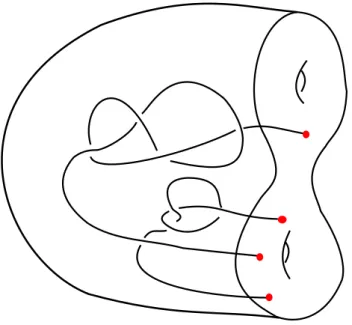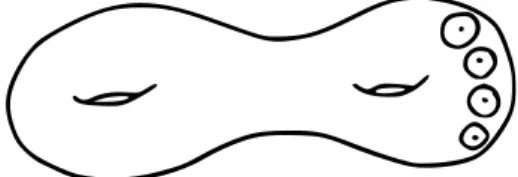In the case of labeled point surfaces, Witten also assumed that the quantization of the moduli spaces of plane parabolic connections should result in the same quantum representations of the corresponding groups of mapping classes (detailed below) that are part of WRT-TQFT - But the mathematical status on the gauge side is missing. The first goal is actually to extend Hitchin's construction of the projective plane connection discussed above to this case of quantization of the moduli space of plane parabolic connections, and this is precisely the focus of this thesis.

Quantization of moduli spaces of flat parabolic connections
Combining this with the explicit description of the Picard group, we get the following result. This result gives us the first Chern class of the moduli stack of parabolic bundlesBΣ.

Complex structure
When we have an almost complex structure, we obtain a splitting of the complexized tangent bundle into the eigenspaces J corresponding to the eigenvalues±i. The almost complex structure J is also integrable if T0MJ preserves the Lie bracket or if the outer differential decomposes as d=∂J+∂J.
Symplectic and Poisson structures
When we talk about the first Chern class of a manifoldM, we mean the first Chern class of the tangent bundleT M. There is a close connection between the first Chern class of T M and the first Chern class of the canonical line bundleK=Vn.
Metaplectic structure
Thus the first Chern class is c1(K) even if and only if the first Chern class of the canonical bundle of MJ is even. Finally: When the first Chern class of the canonical bundle of (M, ω) is even with a compatible almost complex structure, a metaplectic structure provides a canonical choice of square root of the canonical bundle.
Kähler manifolds
Any compatible nearly complex structure J:M → L+M gives an inverse homotopy and thus induces an isomorphism J∗: H2(L+M,Z)→H2(M,Z) that is independent of J.
Curvature
By calculation, we can write δX in terms of the Levi-Civita connection, but then the independence of the Kähler structure is not so obvious. The Laplace de Rahm operator on functions can be expressed in terms of the divergence of z.
Families of Kähler structures
Let us now define the canonical line bundle of a family of Kähler structures as the highest external force of Tˆ0M∗. The curvature of the canonical line bundle of a family of Kähler structures is given by the following theorem, see [5].
Construction of H (k) and H (k)
Let us recall that in canonical quantization we consider wave functions ψ that depend only on, say, the variables qi, and the quantization of coordinate functions is then given by pˆiψ=i~∂q∂iψ and qˆiψ = qiψ. Metaplectic quantization is a modification of geometric quantization that reproduces the canonical harmonic oscillator quantization.
Metaplectic quantization
However, geometric quantization does not actually reproduce the exact quantization of the harmonic oscillator, since the quantization spectrum of the Hamiltonian differs from the exact one by a shift. We are interested in constructing the Hitchin relation, which first preserves only the space of holomorphic sections, but which then predicts an identification of quantum vector spaces for the various corresponding polarizations induced by the family of J we consider. The main purpose of this chapter is to recall the construction of the Hitchin connection in geometric quantization as done in [3] and then to recall the construction of a Hitchin connection in the setting of Metaplectic Quantization as done in [5. ].
Taking the derivative of this in the direction, remembering that ∇ is independent of σ and applying Leibniz's rule, we get
The Hitchin connection in metaplectic quantization
The main focus of this thesis is to construct a Hitchin connection in the case of a surface moduli space with marked points. Let Σ be a compact surface, pa fixed base point, π1(Σ, p) the fundamental group of Σ based on and let G be a compact connected Lie group. Now let us recall the gauge theoretical description of MG and thus realize it as the moduli space of planar G-junctions on Σ.
Conversely, if ρ:π1(Σ, p)→ is a given homomorphism, we consider the trivial Gbundle P˜ = ˜Σ×G over the universal covering space Σ˜ of Σ.
Smooth structure
Let's try to give a brief explanation of the idea behind the proof of why these two definitions are the same; letα be a loop,α(0) =α(1) =p. We must show that for allx∈Σ there exists a neighborhood U such that π:π−1(U)→U×G is an equivariant diffeomorphism, which covers the identity over U. Let U be an open neighborhood q such that in Σ˜ the open neighborhoods of every preimage are disconnected, this can be done since it is the universal cover.
The trivial connection onP˜ (the Maurer-Cartan form withdrawal onG) is invariant under the action of π1 (Σ, p), so it reduces to a flat connection on P.
Tangent space
Symplectic structure
The Chern-Simons line bundle
In this chapter we construct the moduli space of flat joints over a surface with holes. First we define the moduli space of flat connections M( ˜Σ, λ), then in the second part we define the moduli space of parabolic beams Mpar(Σσ, λ). For small enough the moduli space is again homeomorphic (diffeomorphic on the irreducible locus) toM( ˜Σ, λ)σ.
In the last section, we briefly introduce the moduli stacks that we will use in the rest of the chapters in this thesis.

Since the finite group quotients of each of the module spaces MG˜( ˜Σ, C), where G˜ varies through the above groups and C(i)= ˜G∩Cλ(k)(i), are injectively mapped into the reducible locus of M( ˜Σ, λ) and the union of their images covers the entire reducible site, we only need to understand that all module spaces have a dimension at most 4 smaller than M( ˜Σ, λ)0 to understand that the reducible site is in M( ˜Σ, λ) has at least codimension 4. This allows us to see that modulo the finite group quotients are modulo the space of fibers over MG( ˜Σ, C0) with fibers H1(Σ0, ZG˜). Using an elementary counting argument, we observe that the quantity dimG+ dimZG reaches its maximum when we consider G=S(U(n−1)×U(1))∼=U(n−1), so we have that.
The real codimension of the reducible locus in M( ˜Σ, λ) is at least 4, unless we consider the very special case where (g, n) = (2,2) and bi = 0 as described above SU( 2) example, in which case we have that if the number of points p(i) labeled by k is even then the real codimension of the reducible locus is 2.
Definition of the moduli space of parabolic bundles
From this we see of course that if osen >2 or ifg >2, then this is at least 4. A parabolic sheaf is a vector sheaf E → Σ with a quasi-parabolic structure, which is further endowed with parabolic weights α = (α(1),. We say that a parabolic bundleE is (semi)stable if for every subbundleF of E we have that.
Sobolev spaces
Fix a metric Σ˜ compatible with the complex structureΣ such that it bounds to the standard flat metric on the semi-infinite edges ofΣ,h|U(i)\{p(i)}=d(τ(i))2+ d(θ(i))2. Around each hole we have an open neighborhood U(i) that we can map analytically to a semi-infinite cylinder C(i)'S1×[1,∞). We will now define the Sobolev spaces on Σ, which locally at the edges of ˜ Σ˜ are equivalent to those we just defined on the semi-infinite cylinders C(i).
Choose the Riemannian metric g˜onΣ such that it is the same as the standard metric on cylinders.
For sufficiently small and positive, the Ω1,k kernel and the L2 kernel of δA are the same, see [1]. It has been proved by Daskalapoulos and Wentworth in [22] that the trace group G0 is connected and path connected. In Section 3.3 in [22], Daskalapoulos and Wentworth prove that the nearly complex structure coincides with the complex structure of Mehta and Seshadri, Section 2.2, [35].
Hodge theory
With these lemmas established, we obtain the structure of a manifold on the set M( ˜Σ, λ, )0σ and the following cohomology description of the tangent space.
The moduli stack of parabolic bundles B Σ
The later definition of the co-cycle is independent of the choice of path iG0, see [22], Lemma 5.2. So, since Θk satisfies the co-cycle condition and G0 preserves flat connections, we obtain the induced Chern-Simons line bundle over F. Note also that this means that the Chern-Simons line bundle just constructed is a prequantum line bundle, see definition 3.1.
Due to the co-dimension estimates in Section 6.2 and since the reducible locus corresponds to the strictly semi-stable locus, which is a complex subvariation of M( ˜Σ, λ)σ, we see that the singularities of M( ˜Σ , λ )σ has at least a complex co-dimension2.
The mapping class group
It is proved in [8] that for ∇A engtas above, we have Θk(∇A, g0) = 1, which means Diff0(Σ, z, λ) acts trivially on the Chern-Simons line bundle, and thus the action of the mapping of class group increments to an action on the Chern-Simons line bundle:.
Kähler structure parametrized by the Teichmüller space
The first Chern classc1(TMΣσ) of the tangent bundle TMΣσ of the bundle stack is . In Section 9.2 we find the canonical bundle of Q/P, Q→M a main holomorphic GC bundle, and P ⊂GC a parabolic subgroup of GC. In section 9.3 we discuss how to use equation 9 in the case of the moduli stacking of parabolic beams.
This is then used to infer when the canonical bundle of a set of parabolic bundles has a square root.
If this is true, then κ is also in the character setX(P) and hence the line Lκ has a square root in the Picard group Pic(GC/P). As a resultκ is also inX(P)ifhκ,αiˇ is even for all simple roots α and zero for all simple roots in I. The Weyl weight is defined as the sum of the basic weights, so it is an element of the weight latticeX(B )'Pic(B/W).
To check if it is even, we need to calculate hκ,αˇki and check if it is even for allj.
The canonical bundle of the moduli stack of parabolic bundles
As an example we can look at the case, where P is the smallest parabolic subgroup, the Borel subgroup. We proved Theorem 9.4 which states that for GCa semisimple and simply connected Lie group, Q→ M is a principal GC bundle, and P ⊂GC is a parabolic subgroup of GC, the canonical bundle of Q/P . From [8] we have the Picard group of the moduli stack of quasi-parabolic bundles BΣ.
Assume that the weights λ(i) at each labeled point are such that the parabolic subgroup P(i)⊆G associated with the labeled point p(i) is a Borel subgroup of G.
Restricting to SU(n)
Therefore we need to find the sum of roots of SL(n,C) that are not roots of the parabolic subgroup P, since the first Chern class of the canonical line group KB. We are therefore interested in finding all roots of g=sl(n) that are not roots ofp. We already know sec1(KBΣσ,P,B)is even when all parabolic subgroups are Borel subgroups.
If we have a canonical bundle KBΣ ,P that has a square root, bo(P) of the marked points will have κ(i)j odd.
Example: Surface with genus 0 and b punctures
To calculate the class of the symplectic form ωSU(n) onXSU(2), we use the fact that we know the class of the symplectic form ω onX, since it is[ω] = (k(1),. Assume there l∈ Q exists such that the first Chern class of the canonical bundle of M( ˜Σ, λ)0σ isl[ωk,λ]and that the weights λ are contained in the interior of the Weyl chamber From Theorem 7.1 we know we that the Chern-Simons line bundle is a prequantum line bundle since the weights λ are contained in the interior of the Weyl Chamber.
Σσ,P to the moduli space of semi-stable parabolic beamsMpar(Σσ, λ), which induces an injection at the level of the Picard groups. On this moduli space we have an integrable system by means of the Hitchin map. We have now described all the following images so that we get a commutative diagram of vibrations.




